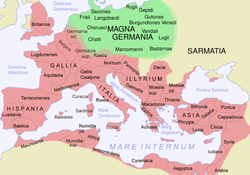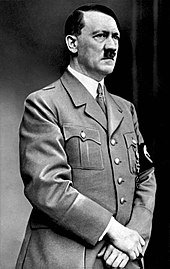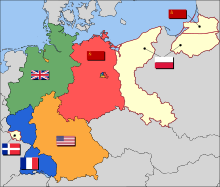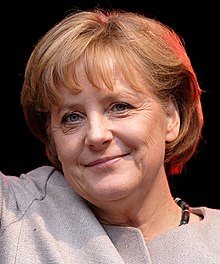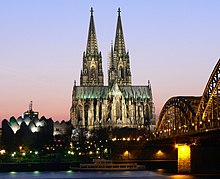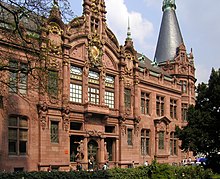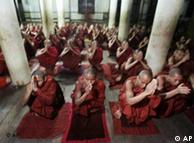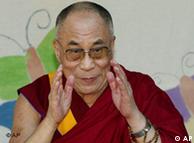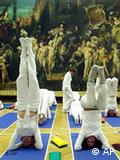Germany (![]() i/ˈdʒɜrməni/), officially the Federal Republic of Germany (German: Bundesrepublik Deutschland, pronounced [ˈbʊndəsʁepuˌbliːk ˈdɔʏtʃlant] (
i/ˈdʒɜrməni/), officially the Federal Republic of Germany (German: Bundesrepublik Deutschland, pronounced [ˈbʊndəsʁepuˌbliːk ˈdɔʏtʃlant] (![]() listen)),[4] is a federal parliamentary republic in Europe. The country consists of 16 stateswhile the capital and largest city is Berlin. Germany covers an area of 357,021 km2 and has a largely temperate seasonal climate. With 81.8 million inhabitants, it is the most populous member state and the largest economy in the European Union. It is one of the major political powers of the European continent and a technological leader in many fields.
listen)),[4] is a federal parliamentary republic in Europe. The country consists of 16 stateswhile the capital and largest city is Berlin. Germany covers an area of 357,021 km2 and has a largely temperate seasonal climate. With 81.8 million inhabitants, it is the most populous member state and the largest economy in the European Union. It is one of the major political powers of the European continent and a technological leader in many fields.
A region named Germania, inhabited by severalGermanic peoples, was documented before AD 100. During the Migration Age, the Germanic tribesexpanded southward, and established successor kingdoms throughout much of Europe. Beginning in the 10th century, German territories formed a central part of the Holy Roman Empire.[5] During the 16th century, northern German regions became the centre of theProtestant Reformation while southern and western parts remained dominated by Roman Catholicdenominations, with the two factions clashing in theThirty Years' War, marking the beginning of the Catholic–Protestant divide that has characterized German society ever since.[6] Occupied during theNapoleonic Wars, the rise of Pan-Germanism inside the German Confederation resulted in the unification of most of the German states into the German Empire in 1871 which was Prussian dominated. After the German Revolution of 1918–1919 and the subsequent military surrender in World War I, the Empire was replaced by the Weimar Republic in 1918, and partitioned in theVersailles Treaty. Amidst the Great Depression, theThird Reich was proclaimed in 1933. The latter period was marked by Fascism and the Second World War. After 1945, Germany was divided by allied occupation, and evolved into two states, East Germany and West Germany. In 1990 Germany was reunified.
Germany was a founding member of the European Community in 1957, which became the EU in 1993. It is part of the Schengen Area and since 1999 a member of the eurozone. Germany is a member of the United Nations, NATO, the G8, the G20, the OECD and theCouncil of Europe, and took a non-permanent seat on the UN Security Council for the 2011–2012 term.
It has the world's fourth largest economy by nominalGDP and the fifth largest by purchasing power parity. It is the second largest exporter and third largest importerof goods. The country has developed a very high standard of living and a comprehensive system of social security. Germany has been the home of many influential scientists and inventors, and is known for itscultural and political history.
Contents[hide] |
Etymology
The English word Germany derives from the Latin Germania, which came into use after Julius Caesaradopted it for the peoples east of the Rhine.[7] In other languages it has various names.
The German term Deutschland (originally diutisciu land, "the German lands") is derived from deutsch, descended from Old High German diutisc "popular" (i. e., belonging to the diot or diota "people"; originally used to distinguish the language of the common people from Latin and its Romance descendants). This in turn descends from Proto-Germanic *þiudiskaz "popular" (see also the Latinised form Theodiscus), derived from *þeudō, descended from Proto-Indo-European *tewtéh₂- "people".[8]
History
Germanic tribes and Frankish Empire
The Germanic tribes are thought to date from theNordic Bronze Age or the Pre-Roman Iron Age. From southern Scandinavia and north Germany, they expanded south, east and west from the 1st century BC, coming into contact with the Celtic tribes of Gaul as well as Iranian, Baltic, and Slavic tribes inEastern Europe.[9] Under Augustus, the Roman General Publius Quinctilius Varus began to invade Germania (an area extending roughly from the Rhineto the Ural Mountains). In AD 9, three Roman legionsled by Varus were defeated by the Cheruscan leaderArminius. By AD 100, when Tacitus wrote Germania, Germanic tribes had settled along the Rhine and the Danube (the Limes Germanicus), occupying most of the area of modern Germany; Austria, southern Bavaria and the western Rhineland, however, were Roman provinces.[10]
In the 3rd century a number of large West Germanic tribes emerged: Alamanni, Franks, Chatti,Saxons, Frisii, Sicambri, and Thuringii. Around 260, the Germanic peoples broke into Roman-controlled lands.[11] After the invasion of the Huns in 375, and with the decline of Rome from 395, Germanic tribes moved further south-west. Simultaneously several large tribes formed in what is now Germany and displaced the smaller Germanic tribes. Large areas (known since the Merovingian period as Austrasia) were occupied by the Franks, and Northern Germany was ruled by the Saxons and Slavs.[10]
Holy Roman Empire
On 25 December 800, Charlemagne founded the Carolingian Empire, which was divided in 843.[12] The Holy Roman Empire resulted from theeastern portion of this division. Its territory stretched from the Eider Riverin the north to the Mediterranean coast in the south.[12] Under the reign of the Ottonian emperors (919–1024), several major duchies were consolidated, and the German king was crowned Holy Roman Emperor of these regions in 962. The Holy Roman Empire absorbed northern Italy and Burgundy under the reign of the Salian emperors (1024–1125), although the emperors lost power through the Investiture Controversy.
Under the Hohenstaufen emperors (1138–1254), the German princes increased their influence further south and east into territories inhabited by Slavs, preceding German settlement in these areas and further east(Ostsiedlung). Northern German towns grew prosperous as members of the Hanseatic League.[13] Starting with the Great Famine in 1315, then the Black Death of 1348–50, the population of Germany plummeted.[14]The edict of the Golden Bull in 1356 provided the basic constitution of the empire and codified the election of the emperor by seven prince-electors who ruled some of the most powerful principalities and archbishoprics.[15]
Martin Luther publicised his 95 Theses in 1517, challenging the Roman Catholic Church and initiating the Protestant Reformation. A separate Lutheran church became the official religion in many German states after 1530. Religious conflict led to the Thirty Years' War (1618–1648), which devastated German lands.[16] The population of the German states was reduced by about 30%.[17] The Peace of Westphalia (1648) ended religious warfare among the German states, but the empire was de factodivided into numerous independent principalities. From 1740 onwards, dualism between the AustrianHabsburg Monarchy and the Kingdom of Prussia dominated German history. In 1806, the Imperiumwas overrun and dissolved as a result of the Napoleonic Wars.[18]
German Confederation and Empire
Following the fall of Napoleon I of France, the Congress of Vienna convened in 1814 and founded the German Confederation (Deutscher Bund), a loose league of 39 sovereign states. Disagreement withrestoration politics partly led to the rise of liberal movements, followed by new measures of repression by Austrian statesman Metternich. The Zollverein, a tariff union, furthered economic unity in the German states.[19] National and liberal ideals of the French Revolution gained increasing support among many, especially young, Germans. In the light of a series of revolutionary movements in Europe, which established a republic in France, intellectuals and commoners started the Revolutions of 1848 in the German states. King Frederick William IV of Prussia was offered the title of Emperor, but with a loss of power; he rejected the crown and the proposed constitution, leading to a temporary setback for the movement.[20]
Conflict between King William I of Prussia and the increasingly liberal parliament erupted over military reforms in 1862, and the king appointed Otto von Bismarck the newPrime Minister of Prussia. Bismarck successfully wagedwar on Denmark in 1864. Prussian victory in the Austro-Prussian War of 1866 enabled him to create the North German Federation (Norddeutscher Bund) and to excludeAustria, formerly the leading German state, from the federation's affairs. After the French defeat in the Franco-Prussian War, the German Empire was proclaimed 1871 inVersailles, uniting all scattered parts of Germany except Austria (Kleindeutschland, or "Lesser Germany"). With almost two thirds of its territory and population, Prussia was the dominating constituent of the new state; the Hohenzollern King of Prussia ruled as its concurrent Emperor, and Berlin became its capital.[20] In the Gründerzeit period following theunification of Germany, Bismarck's foreign policy as Chancellor of Germany under Emperor William I secured Germany's position as a great nation by forging alliances, isolating France by diplomatic means, and avoiding war. Under Wilhelm II, however, Germany, like other European powers, took animperialistic course leading to friction with neighbouring countries. As a result of the Berlin Conferencein 1884 Germany claimed several colonies including German East Africa, German South-West Africa,Togo, and Cameroon.[21] Most alliances in which Germany had previously been involved were not renewed, and new alliances excluded the country.[22]
The assassination of Austria's crown prince on 28 June 1914 triggered World War I. Germany, as part of the Central Powers, suffered defeat against the Allies in one of the bloodiest conflicts of all time. An estimated two million German soldiers died in World War I.[23] The German Revolution broke out in November 1918, and Emperor Wilhelm II and all German ruling princes abdicated. An armistice ended the war on 11 November, and Germany was forced to sign the Treaty of Versailles in June 1919. The treaty was perceived in Germany as a humiliating continuation of the war, and is often cited as an influence in the rise of Nazism.[24]
Weimar Republic and Third Reich
At the beginning of the German Revolution in November 1918, Germany was declared a republic. However, the struggle for power continued, with radical-left communists seizing power in Bavaria. The revolution came to an end on 11 August 1919, when theWeimar Constitution was signed by President Friedrich Ebert.[26]Suffering from the Great Depression, the harsh peace conditions dictated by the Treaty of Versailles, and a long succession of unstable governments, Germans increasingly lacked identification with the government. This was exacerbated by a widespread right-wing Dolchstoßlegende, or stab-in-the-back myth, which argued that Germany had lost World War I because of those who wanted to overthrow the government. The Weimar government was accused of betraying Germany by signing the Versailles Treaty. By 1932, theGerman Communist Party and the Nazi Party controlled the majority of parliament, fuelled by discontent with the Weimar government. After a series of unsuccessful cabinets, President Paul von Hindenburg appointed Adolf Hitler as Chancellor of Germany on 30 January 1933.[27] On 27 February 1933 the Reichstag building went up in flames, and a consequent emergency decree abrogated basic citizens' rights. An Enabling Act passed in parliament gave Hitler unrestricted legislative power. Only the Social Democratic Party voted against it, while Communist MPs had already been imprisoned.[28][29] Using his powers to crush any actual or potential resistance, Hitler established a centralised totalitarian state within months. Industry was revitalised with a focus on military rearmament.[30]
In 1935, Germany reacquired control of the Saar and in 1936 military control of the Rhineland, both of which had been lost in the Treaty of Versailles.[31] In 1938 and 1939, Austria and Czechoslovakia were brought under German control and the invasion of Poland was prepared through the Molotov–Ribbentrop pact and Operation Himmler. On 1 September 1939 the German Wehrmacht launched ablitzkrieg on Poland, which was swiftly occupied by Germany and by the Soviet Red Army. The UK and France declared war on Germany, marking the beginning of World War II.[32] As the war progressed, Germany and its allies quickly gained control of much of continental Europe though plans to occupy the United Kingdom failed. On 22 June 1941, Germany broke the Molotov–Ribbentrop pact and invaded the Soviet Union. Japan's attack on Pearl Harbor led Germany to declare war on the United States. The Battle of Stalingrad forced the German army to retreat on the Eastern front.[32] In September 1943, Germany's ally Italy surrendered, and German troops were forced to defend an additional front in Italy. D-Day opened a Western front, as Allied forces advanced towards German territory. On 8 May 1945, the German armed forces surrendered after the Red Army occupied Berlin.[33]
In what later became known as The Holocaust, the Third Reich regime had enacted policies directly subjugating many dissidents and minorities. Millions of people were murdered by the Nazis during the Holocaust, including a sizeable number of Jews, Gypsies, Jehovah's Witnesses,Poles and other Slavs, including Soviet POWs, people with mental and/or physical disabilities, homosexuals, andmembers of the political opposition.[34] World War II was responsible for more than 40 million dead in Europe.[35] TheNuremberg trials of Nazi war criminals were held after World War II.[36] The war casualties for Germany are estimated at 5.3 million German soldiers[37] millions of German civilians;[38][39][40][41][42] and losing the war resulted in large territorial losses; the expulsion of about 15 million Germans from the eastern areas of Germany and other countries; mass rape of German women;[43] and the destruction of multiple major cities.
East and West Germany
After the surrender of Germany, the remaining German territory and Berlin were partitioned by the Allies into four military occupation zones. The western sectors, controlled by France, the United Kingdom, and the United States, were merged on 23 May 1949 to form the Federal Republic of Germany (Bundesrepublik Deutschland); on 7 October 1949, the Soviet Zone became the German Democratic Republic (Deutsche Demokratische Republik, or DDR). They were informally known as "West Germany" and "East Germany". East Germany selected East Berlin as its capital, while West Germany chose Bonn as a provisional capital, to emphasise its stance that the two-state solution was an artificial and temporary status quo.[44]
West Germany, established as a federal parliamentary republic with a "social market economy", was allied with the United States, the UK and France. The country enjoyed prolonged economic growth beginning in the early 1950s (Wirtschaftswunder). West Germany joined NATO in 1955 and was a founding member of theEuropean Economic Community in 1957. East Germany was an Eastern bloc state under political and military control by the USSR via the latter's occupation forces and the Warsaw Pact. Though East Germany claimed to be a democracy, political power was exercised solely by leading members (Politbüro) of the communist-controlled Socialist Unity Party of Germany (SED), supported by theStasi, an immense secret service,[45] and a variety of sub-organisations controlling every aspect of society. A Soviet-style command economy was set up; the GDR later became a Comecon state.[46]While East German propaganda was based on the benefits of the GDR's social programmes and the alleged constant threat of a West German invasion, many of her citizens looked to the West for freedom and prosperity.[47] The Berlin Wall, built in 1961 to stop East Germans from escaping to West Germany, became a symbol of the Cold War.[20]
Tensions between East and West Germany were reduced in the early 1970s by Chancellor Willy Brandt's Ostpolitik. In summer 1989, Hungary decided to dismantle the Iron Curtain and open the borders, causing the emigration of thousands of East Germans to West Germany via Hungary. This had devastating effects on the GDR, where regularmass demonstrations received increasing support. The East German authorities unexpectedly eased the border restrictions, allowing East German citizens to travel to the West; originally intended to help retain East Germany as a state, the opening of the border actually led to an acceleration of the Wende reform process. This culminated in the Two Plus Four Treaty a year later on 12 September 1990, under which the four occupying powers renounced their rights under the Instrument of Surrender, and Germany regained full sovereignty. This permittedGerman reunification on 3 October 1990, with the accession of the five re-established states of the former GDR (new states or "neue Länder").[20]
Berlin Republic and the EU
Based on the Berlin/Bonn Act, adopted on 10 March 1994, Berlin once again became the capital of the reunified Germany, while Bonn obtained the unique status of a Bundesstadt (federal city) retaining some federal ministries.[48] The relocation of the government was completed in 1999.[49] Since reunification, Germany has taken a more active role in the European Union and NATO. Germany sent a peacekeeping force to secure stability in the Balkans and sent a force of German troops toAfghanistan as part of a NATO effort to provide security in that country after the ousting of theTaliban.[50] These deployments were controversial since, after the war, Germany was bound by domestic law only to deploy troops for defence roles.[51] In 2005, Angela Merkel became the first female Chancellor of Germany as the leader of a grand coalition.[20]
Geography
Germany is in Western and Central Europe, bordering Denmark in the north, Poland and the Czech Republic in the east, Austria andSwitzerland in the south, France and Luxembourg in the south-west, and Belgium and the Netherlands in the north-west. It lies mostly between latitudes 47° and 55° N (the tip of Sylt is just north of 55°), and longitudes 5° and 16° E. The territory covers 357,021 km2 (137,847 sq mi), consisting of 349,223 km2 (134,836 sq mi) of land and 7,798 km2 (3,011 sq mi) of water. It is the seventh largest country by area in Europe and the 62nd largest in the world.[52]
Elevation ranges from the mountains of the Alps (highest point: theZugspitze at 2,962 metres / 9,718 feet) in the south to the shores of theNorth Sea (Nordsee) in the north-west and the Baltic Sea (Ostsee) in the north-east. The forested uplands of central Germany and the lowlands of northern Germany (lowest point: Wilstermarsch at 3.54 metres / 11.6 feet below sea level) are traversed by such major rivers as the Rhine, Danube and Elbe. Glaciers are found in the Alpine region, but are experiencing deglaciation. Significant natural resources are iron ore, coal, potash, timber, lignite, uranium, copper, natural gas, salt, nickel, arable land and water.[52]
Climate
Most of Germany has a temperate seasonal climate in which humid westerly winds predominate. The climate is moderated by the North Atlantic Drift, the northern extension of the Gulf Stream. This warmer water affects the areas bordering the North Sea; consequently in the north-west and the north the climate is oceanic. Rainfall occurs year-round, especially in the summer. Winters are mild and summers tend to be cool, though temperatures can exceed 30 °C (86 °F).[53]
The east has a more continental climate; winters can be very cold and summers very warm, and long dry periods are frequent. Central and southern Germany are transition regions which vary from moderately oceanic to continental. In addition to the maritime and continental climates that predominate over most of the country, the Alpine regions in the extreme south and, to a lesser degree, some areas of the Central German Uplands have a mountain climate, characterised by lower temperatures and greater precipitation.[53]
Biodiversity
The territory of Germany can be subdivided into twoecoregions: European-Mediterranean montane mixed forests and Northeast-Atlantic shelf marine.[54] As of 2008 the majority of Germany is covered by either arable land (34%) or forest and woodland (30.1%); only 13.4% of the area consists of permanent pastures, 11.8% is covered by settlements and streets.[55]
Plants and animals are those generally common to middle Europe. Beeches, oaks, and other deciduous trees constitute one third of the forests; conifers are increasing as a result of reforestation. Spruce and fir trees predominate in the upper mountains, while pine and larch are found in sandy soil. There are many species of ferns, flowers, fungi, and mosses. Wild animals include deer, wild boar, mouflon, fox, badger, hare, and small numbers of beavers.[56]
The national parks in Germany include the Wadden Sea National Parks, the Jasmund National Park, the Vorpommern Lagoon Area National Park, the Müritz National Park, the Lower Oder Valley National Park, the Harz National Park, the Saxon Switzerland National Park and the Bavarian Forest National Park. More than 400 registered zoos and animal parks operate in Germany, which is believed to be the largest number in any country.[57] The Zoologische Garten Berlin is the oldest zoo in Germany and presents the most comprehensive collection of species in the world.[58]
Politics
Germany is a federal, parliamentary, representative democratic republic. The German political system operates under a framework laid out in the 1949 constitutional document known as the Grundgesetz (Basic Law). Amendments generally require a two-thirds majority of both chambers of parliament; the fundamental principles of the constitution, as expressed in the articles guaranteeing human dignity, the separation of powers, the federal structure, and the rule of law are valid in perpetuity.[59]
The president, currently Christian Wulff, is the head of state and invested primarily with representative responsibilities and powers. He is elected by the Bundesversammlung (federal convention), an institution consisting of the members of the Bundestag and an equal number of state delegates. The second-highest official in the German order of precedence is the Bundestagspräsident (President of the Bundestag), who is elected by the Bundestag and responsible for overseeing the daily sessions of the body. The third-highest official and the head of government is the Chancellor, who is appointed by the Bundespräsident after being elected by the Bundestag.[20]
The chancellor, currently Angela Merkel, is the head of government and exercises executive power, similar to the role of a Prime Minister in other parliamentary democracies. Federal legislative power is vested in the parliament consisting of the Bundestag (Federal Diet) and Bundesrat (Federal Council), which together form the legislative body. The Bundestag is elected through direct elections, byproportional representation (mixed-member).[52] The members of the Bundesrat represent the governments of the sixteen federated states and are members of the state cabinets.[20]
Since 1949, the party system has been dominated by the Christian Democratic Union and the Social Democratic Party of Germany with all chancellors hitherto being member of either party. However, the smaller liberal Free Democratic Party (which has had members in the Bundestag since 1949) and theAlliance '90/The Greens (which has controlled seats in parliament since 1983) have also played important roles.[60]
Germany has a civil law system based on Roman law with some references to Germanic law. TheBundesverfassungsgericht (Federal Constitutional Court) is the German Supreme Court responsible for constitutional matters, with power of judicial review.[20][61] Germany's supreme court system, calledOberste Gerichtshöfe des Bundes, is specialised: for civil and criminal cases, the highest court of appeal is the inquisitorial Federal Court of Justice, and for other affairs the courts are the Federal Labour Court, the Federal Social Court, the Federal Finance Court and the Federal Administrative Court. The Völkerstrafgesetzbuch regulates the consequences of crimes against humanity, genocideand war crimes, and gives German courts universal jurisdiction in some circumstances.[62] Criminal and private laws are codified on the national level in the Strafgesetzbuch and the Bürgerliches Gesetzbuch respectively. The German penal system is aimed towards rehabilitation of the criminal and the protection of the general public.[63] Except for petty crimes, which are tried before a single professional judge, and serious political crimes, all charges are tried before mixed tribunals on whichlay judges (Schöffen) sit side by side with professional judges.[64][65]
Constituent states
Germany comprises sixteen states that are collectively referred to as Länder.[66] Each state has its own state constitution[67] and is largely autonomous in regard to its internal organisation. Due to differences in size and population the subdivision of these states varies, especially between city states(Stadtstaaten) and states with larger territories (Flächenländer). For regional administrative purposes five states, namely Baden-Württemberg, Bavaria, Hesse, North Rhine-Westphalia and Saxony, consist of a total of 22 Government Districts (Regierungsbezirke). As of 2009 Germany is divided into 403districts (Kreise) on municipal level, these consist of 301 rural districts and 102 urban districts.[68]
|
Foreign relations
Germany has a network of 229 diplomatic missions abroad and maintains relations with more than 190 countries.[69]As of 2011 it is the largest contributor to the budget of the European Union (providing 20%)[70] and the third largest contributor to the UN (providing 8%).[71] Germany is a member of NATO, the Organisation of Economic Co-operation and Development (OECD), the G8, the G20, the World Bank and the International Monetary Fund (IMF). It has played a leading role in the European Union since its inception and has maintained a strong alliance with Francesince the end of World War II. Germany seeks to advance the creation of a more unified European political, defence, and security apparatus.[72][73]
The development policy of the Federal Republic of Germany is an independent area of German foreign policy. It is formulated by the Federal Ministry for Economic Cooperation and Development (BMZ) and carried out by the implementing organisations. The German government sees development policy as a joint responsibility of the international community.[74] It is the world's third biggest aid donor after the United States and France.[75][76]
During the Cold War, Germany's partition by the Iron Curtain made it a symbol of East-West tensions and a political battleground in Europe. However, Willy Brandt's Ostpolitik was a key factor in thedétente of the 1970s.[77] In 1999, Chancellor Gerhard Schröder's government defined a new basis for German foreign policy by taking part in the NATO decisions surrounding the Kosovo War and by sending German troops into combat for the first time since World War II.[78] The governments of Germany and the United States are close political allies.[20] The 1948 Marshall Plan and strong cultural ties have crafted a strong bond between the two countries, although Schröder's vocal opposition to the Iraq War suggested the end of Atlanticism and a relative cooling of German-American relations.[79] The two countries are also economically interdependent: 8.8% of German exports are U.S.-bound and 6.6% of German imports originate from the U.S.[80]
Military
Germany's military, the Bundeswehr, is organized in Heer(Army), Marine (Navy), Luftwaffe (Air Force), Zentraler Sanitätsdienst (Central Medical Services) andStreitkräftebasis (Joint Support Service) branches. As of 2005, military spending was an estimated 1.5% of the country's GDP, that is position 99 in a ranking of all countries;[52] absolutely, German military expenditure is the eighth-highest in the world.[81] In peacetime, the Bundeswehr is commanded by the Minister of Defence. If Germany went to war, which according to the constitution is allowed only for defensive purposes, the Chancellor would become commander in chief of the Bundeswehr.[82]
As of May 2011 the Bundeswehr employs 188,000 professional soldiers, 31,000 18–25 year-old conscripts who serve for at least six months.[83] The German government plans to reduce the number of soldiers to 170,000 professionals and up to 15,000 short-time volunteers (voluntary military service).[84] Reservists are available to the Armed Forces and participate in defence exercises and deployments abroad, a new reserve concept of their future strength and functions was announced 2011.[84] As of April 2011, the German military had about 6,900 troops stationed in foreign countries as part of international peacekeeping forces, including about 4,900 Bundeswehr troops in the NATO-led ISAF force in Afghanistan and Uzbekistan, 1,150 German soldiers in Kosovo, and 300 troops withUNIFIL in Lebanon.[85]
Until 2011, military service was compulsory for men at age 18, and conscripts served six-month tours of duty; conscientious objectors could instead opt for an equal length of Zivildienst (civilian service), or a six-year commitment to (voluntary) emergency services like a fire department or the Red Cross. On 1 July 2011 conscription was officially suspended and replaced with a voluntary service.[86][87] Since 2001 women may serve in all functions of service without restriction, but they are not subject to conscription. There are presently some 17,500 women on active duty and a number of female reservists.[88]
Economy
Germany has a social market economy with a highly qualified labour force, a large capital stock, a low level of corruption,[90] and a high level of innovation.[91] It has the largest national economy in Europe, the fourth largest by nominal GDP in the world,[92] and the fifth largest by PPP[92] in 2009. The service sector contributes approximately 71% of the total GDP, industry 28%, and agriculture 0.9%.[52] The average national unemployment rate in 2010 was about 7.5%.[52] First estimates indicate a 3.6% increase in the price-adjusted GDP for 2010, following a 4.7% drop in 2009.[93]
Germany is a founding member of the EU, the G8 and the G20, and was the world's largest exporter from 2003 to 2008. In 2009 it remained the second largest exporter and third largest importer of goods. Most of the country's exports are in engineering, especially machinery, automobiles, chemical goods and metals.[52] Germany is a leading producer of wind turbines and solar-power technology.[94] Annual trade fairs and congresses are held in cities throughout Germany.[95]
Germany is an advocate of closer European economic and political integration. Its commercial policies are increasingly determined by agreements among European Union (EU) members and by EU legislation. Germany introduced the common European currency, the euro, on 1 January 2002.[96][97]Its monetary policy is set by the European Central Bank. Two decades after German reunification,standards of living and per capita incomes remain significantly higher in the states of the former West Germany than in the former East.[98] The modernisation and integration of the eastern German economy is a long-term process scheduled to last until the year 2019, with annual transfers from west to east amounting to roughly $80 billion.[99] In January 2009 the German government approved a €50 billion economic stimulus plan to protect several sectors from a downturn and a subsequent rise in unemployment rates.[100]
Of the world's 500 largest stock-market-listed companies measured by revenue in 2010, the Fortune Global 500, 37 are headquartered in Germany. 30 Germany-based companies are included in the DAX, the German stock market index. Well-known global brands are Mercedes-Benz, BMW, SAP,Siemens, Volkswagen, Adidas, Audi, Allianz, Porsche, and Nivea.[101] Germany is recognised for its specialised small and medium enterprises. Around 1,000 of these companies are global market leaders in their segment and are labelled hidden champions.[102]
The list includes the largest companies by turnover in 2009. Unranked are the largest bank and the largest insurance company in 2007:
| Rank[103] | Name | Headquarters | Revenue (Mil. €) | Profit (Mil. €) | Employees (World) |
|---|---|---|---|---|---|
| 1 | Volkswagen AG | Wolfsburg | 108,897 | 4,120 | 329,305 |
| 2 | Daimler AG | Stuttgart | 99,399 | 3,985 | 272,382 |
| 3 | Siemens AG | Munich/Berlin | 72,488 | 3,806 | 398,200 |
| 4 | E.ON AG | Düsseldorf | 68,731 | 7,204 | 87,815 |
| 5 | Metro AG | Düsseldorf | 64,337 | 825 | 242,378 |
| 6 | Deutsche Post AG | Bonn | 63,512 | 1,389 | 475,100 |
| 7 | Deutsche Telekom AG | Bonn | 62,516 | 569 | 241,426 |
| 8 | BASF SE | Ludwigshafen | 57,951 | 4,065 | 95,175 |
| 9 | BMW AG | Munich | 56,018 | 3,126 | 107,539 |
| 10 | ThyssenKrupp AG | Essen/Duisburg | 51,723 | 2,102 | 191,350 |
Infrastructure
With its central position in Europe, Germany is a transport hub. This is reflected in its dense and modern transport networks. The motorway (Autobahn) network ranks as the third largest worldwide in length.[104] Germany has established a polycentric network of high-speed trains. TheInterCityExpress or ICE network of the Deutsche Bahnserves major German cities as well as destinations in neighbouring countries.[105] The largest German airports are Frankfurt Airport and Munich Airport, both hubs ofLufthansa, while Air Berlin has hubs at Berlin Tegel andDüsseldorf. Other major airports include Berlin Schönefeld,Hamburg, Cologne/Bonn and Leipzig/Halle. Both airports in Berlin will be consolidated at a site adjacent to Berlin Schönefeld, which will become Berlin Brandenburg Airport in 2012.[106]
As of 2008, Germany was the world's sixth largest consumer of energy,[107] and 60% of its primary energy was imported.[108] Government policy promotes energy conservation and renewable energy.Energy efficiency has been improving since the early 1970s; the government aims to meet the country's electricity demands using only renewable sources by 2050.[109] In 2010, energy sources were: oil (33.7%); coal, including lignite (22.9%); natural gas (21.8%); nuclear (10.8%); hydro-electric and wind power (1.5%); and other renewable sources (7.9%).[110] In 2000, the government and thenuclear power industry agreed to phase out all nuclear power plants by 2021.[111] Germany is committed to the Kyoto protocol and several other treaties promoting biodiversity, low emission standards, recycling, and the use of renewable energy, and supports sustainable development at a global level.[112] The German government has initiated wide-ranging emission reduction activities and the country's overall emissions are falling.[113] Nevertheless the country's greenhouse gas emissionswere the highest in the EU as of 2007.[114]
Science and technology
Germany's achievements in sciences have been significant, andresearch and development efforts form an integral part of theeconomy.[115] The Nobel Prize has been awarded to 103 German laureates.[116] For most of the 20th century, German laureates had more awards than those of any other nation, especially in the sciences (physics, chemistry, and physiology or medicine).[117][118]
The work of Albert Einstein and Max Planck was crucial to the foundation of modern physics, which Werner Heisenberg and Max Born developed further.[119] Wilhelm Conrad Röntgen discovered X-rays and was the first winner of the Nobel Prize in Physics in 1901.[120] Numerous mathematicians were born in Germany, including Carl Friedrich Gauss, David Hilbert, Bernhard Riemann,Gottfried Leibniz, Karl Weierstrass, Hermann Weyl and Felix Klein. Research institutions in Germany include the Max Planck Society, the Helmholtz Association and the Fraunhofer Society. The Gottfried Wilhelm Leibniz Prize is granted to ten scientists and academics every year. With a maximum of €2.5 million per award it is one of highest endowed research prizes in the world.[121]
Germany has been the home of many famous inventors and engineers, such as Johannes Gutenberg, credited with the invention of movable type printing in Europe; Hans Geiger, the creator of the Geiger counter; and Konrad Zuse, who built the first fully automatic digital computer.[122] German inventors, engineers and industrialists such as Count Ferdinand von Zeppelin, Otto Lilienthal, Gottlieb Daimler,Rudolf Diesel, Hugo Junkers and Karl Benz helped shape modern automotive and air transportation technology.[123] Aerospace engineer Wernher von Braun developed the first space rocket and later on was a prominent member of NASA and developed the Saturn V Moon rocket, which paved the way for the success of the US Apollo program. Heinrich Rudolf Hertz's work in the domain of electromagnetic radiation was pivotal to the development of modern telecommunication.[124]
Germany is also one of the leading countries in developing and using green technologies. Companies specializing in green technology have an estimated turnover of 200€ billion. Especially the expertise in engineering, science and research of Germany is eminently respectable. The lead markets of Germany's green technology industry are power generation, sustainable mobility, material efficiency, energy efficiency, waste management and recycling, sustainable water management.[125]
Demographics
With its estimated population of 81.8 million in January 2010,[1] Germany is the most populous country in the European Union and ranks as the 15th most populous country in the world.[126] Itspopulation density stands at 229.4 inhabitants per square kilometre. The overall life expectancy in Germany at birth is 79.9 years. The fertility rate of 1.4 children per mother, or 7.9 births per 1000 inhabitants in 2009, is one of the lowest in the world.[127] Since the 1990s, Germany's death rate has continuously exceeded its birth rate.[128] The Federal Statistical Office of Germany forecast that the population will shrink to between 65 and 70 million by 2060 (depending on the level of net migration).[129]
German nationals make up 91% of the population of Germany. As of 2009, about seven million foreign citizens were registered in Germany, and 19% of the country's residents were of foreign or partially foreign descent (including persons descending or partially descending fromethnic German repatriates), 96% of whom lived in Western Germany or Berlin.[130] The United Nations Population Fund lists Germany as host to the third-highest number of international migrants worldwide, about 5% or 10 million of all 191 million migrants.[131] As a consequence ofrestrictions to Germany's formerly rather unrestricted laws on asylum and immigration, the number of immigrants seeking asylum or claiming German ethnicity (mostly from the former Soviet Union) has been declining steadily since 2000.[132] In 2009, 20% of the population had immigrant roots, the highest since 1945.[133] As of 2008, the largest national group was from Turkey (2.5 million), followed by Italy (776,000) and Poland (687,000).[134] About 3 million "Aussiedler"—ethnic Germans, mainly from Eastern Europe and the former Soviet Union—have resettled in Germany since 1987.[135]
Germany has a number of large cities. The largest conurbation is the Rhine-Ruhr region (11.5 million as of 2006), including Düsseldorf (the capital of North Rhine-Westphalia), Cologne, Dortmund, Essen,Duisburg, and Bochum.[136]
| Largest cities of Germany List of statistical offices in Germany 24 December 2010 | |||||||||
|---|---|---|---|---|---|---|---|---|---|
| Rank | City name | State | Pop. | Rank | City name | State | Pop. | ||
 Berlin | 1 | Berlin | Berlin | 3,471,756 | 11 | Dresden | Saxony | 523,058 |  Munich |
| 2 | Hamburg | Hamburg | 1,786,448 | 12 | Leipzig | Saxony | 522,883 | ||
| 3 | Munich | Bavaria | 1,353,186 | 13 | Hannover | Lower Saxony | 522,686 | ||
| 4 | Cologne | North Rhine-Westphalia | 1,007,119 | 14 | Nuremberg | Bavaria | 505,664 | ||
| 5 | Frankfurt | Hessen | 688,664 | 15 | Duisburg | North Rhine-Westphalia | 489,599 | ||
| 6 | Stuttgart | Baden-Württemberg | 606,588 | 16 | Bochum | North Rhine-Westphalia | 374,737 | ||
| 7 | Düsseldorf | North Rhine-Westphalia | 598,786 | 17 | Wuppertal | North Rhine-Westphalia | 349,721 | ||
| 8 | Dortmund | North Rhine-Westphalia | 580,444 | 18 | Bonn | North Rhine-Westphalia | 324,899 | ||
| 9 | Essen | North Rhine-Westphalia | 574,635 | 19 | Bielefeld | North Rhine-Westphalia | 323,270 | ||
| 10 | Bremen | Bremen (state) | 547,340 | 20 | Mannheim | Baden-Württemberg | 313,174 | ||
Religion
Christianity is the largest religion in Germany, with around 51.5 million adherents (62.8%) in 2008,[137] of which 30.0% are Catholics and 29.9% are Protestants, belonging to theEvangelical Church in Germany (EKD); the remainder consists of small denominations (each less than 0.5% of the German population).[138] Protestantism is concentrated in the north and east and Roman Catholicism is concentrated in the south and west;[6] 1.6% of the country's overall population declare themselves Orthodox Christians.[137]
The second largest religion is Islam with an estimated 3.8 to 4.3 million adherents (4.6% to 5.2%),[139] followed byBuddhism with 250,000 and Judaism with around 200,000 adherents (0.3%); Hinduism has some 90,000 adherents (0.1%). All other religious communities in Germany have fewer than 50,000 adherents.[140] Of the roughly 4 million Muslims, most are Sunnisand Alevites from Turkey, but there are a small number of Shi'ites and other denominations.[139]German Muslims, a large portion of whom are of Turkish origin, lack full official state recognition of their religious community.[6] Germany has Europe's third largest Jewish population (after France and the United Kingdom).[141] Approximately 50% of the Buddhists in Germany are Asian immigrants.[142]
Germans with no stated religious adherence make up 34.1% of the population, especially in the formerEast Germany and major metropolitan areas.[138] German reunification in 1990 greatly increased the country’s non-religious population, a legacy of the state atheism of the previously Soviet-controlled East. Christian church membership has decreased in recent decades, particularly among Protestants.[6]
Languages
German is the official and predominant spoken language in Germany.[143] It is one of 23 official languages in the European Union, and one of the three working languages of the European Commission. Recognised native minority languages in Germany are Danish, Low German, Sorbian,Romany, and Frisian; they are officially protected by the ECRML. The most used immigrant languages are Turkish, Kurdish, Polish, the Balkan languages, and Russian; 67% of German citizens claim to be able to communicate in at least one foreign language and 27% in at least two languages other than their own.[143]
Standard German is a West Germanic language and is closely related to and classified alongside English, Low German, Dutch, and the Frisian languages. To a lesser extent, it is also related to theEast (extinct) and North Germanic languages. Most German vocabulary is derived from the Germanic branch of the Indo-European language family.[144] Significant minorities of words are derived from Latin and Greek, with a smaller amount from French and most recently English (known as Denglisch). German is written using the Latin alphabet. German dialects, traditional local varieties traced back to the Germanic tribes, are distinguished from varieties of standard German by their lexicon, phonology, and syntax.[145]
Education
Over 99% of Germans age 15 and above are estimated to be able to read and write.[52] However, a growing number of inhabitants are functionally illiterate.[146] Responsibility for educational oversight in Germany lies primarily with the individual federated states. Since the 1960s, a reform movement attempted to unify secondary education in aGesamtschule (comprehensive school); several West German states later simplified their school system to two or three tiers. A system of apprenticeship called Duale Ausbildung ("dual education") allows pupils in vocational training to learn in a company as well as in a state-run vocational school.[147]
Optional kindergarten education is provided for all children between three and six years old, after which school attendance is compulsory for at least nine years. Primary education usually lasts for four years and public schools are not stratified at this stage.[147] In contrast, secondary education includes three traditional types of schools focused on different levels of academic ability: the Gymnasium enrols the most gifted children and prepares students for university studies; the Realschule for intermediate students lasts six years; the Hauptschule prepares pupils for vocational education.[148]
The general entrance requirement for university is Abitur, a qualification normally based on continuous assessment during the last few years at school and final examinations; however there are a number of exceptions, and precise requirements vary, depending on the state, the university and the subject. Germany's universities are recognised internationally; in the Academic Ranking of World Universities(ARWU) for 2008, six of the top 100 universities in the world are in Germany, and 18 of the top 200.[149] Nearly all German universities are public institutions, charging tuition fees of €50–500 per semester for each student.[150]
Health
Germany has the world's oldest universal health care system, dating back to Otto von Bismarck'sSocial legislation in 1883.[151] Currently the population is covered by a basic health insurance plan provided by statute. According to the World Health Organization, Germany's health care system was 77% government-funded and 23% privately funded as of 2005.[152] In 2005, Germany spent 11% of its GDP on health care. Germany ranked 20th in the world in life expectancy with 77 years for men and 82 years for women, and it had a very low infant mortality rate (4 per 1,000 live births).[152]
As of 2009, the principal cause of death was cardiovascular disease, at 42%, followed by malignant tumours, at 25%.[153] As of 2008, about 82,000 Germans had been infected with HIV/AIDS and 26,000 had died from the disease (cumulatively, since 1982).[154] According to a 2005 survey, 27% of German adults are smokers.[154] A 2007 study shows Germany has the highest number of overweight people in Europe.[155][156]
Culture
From its roots, culture in Germany has been shaped by major intellectual and popular currents in Europe, both religious andsecular. Historically Germany has been called Das Land der Dichter und Denker (the land of poets and thinkers).[157] The federated states are in charge of the cultural institutions. There are 240 subsidised theatres, hundreds of symphonic orchestras, thousands of museums and over 25,000 libraries spread in Germany. These cultural opportunities are enjoyed by many: there are over 91 million German museum visits every year; annually, 20 million go to theatres and operas; 3.6 million per year listen to the symphonic orchestras.[158] The UNESCO inscribed 33 properties in Germany on the World Heritage List.[159]
Germany has established a high level of gender equality,[160]promotes disability rights, and is legally and socially tolerant towards homosexuals. Gays and lesbians can legally adopt their partner's biological children, and civil unions have been permitted since 2001.[161] Germany has also changed its attitude towards immigrants; since the mid-1990s, the government and the majority of Germans have begun to acknowledge that controlled immigration should be allowed based on qualification standards.[162]Germany has been named the world's second most valued nation among 50 countries in 2010.[163] A global opinion poll for the BBC revealed that Germany is recognised for having the most positive influence in the world in 2011.[164]
Arts
| J.S.Bach Toccata und Fuge | L.v. Beethoven Symphonie 5 c-moll | R. Wagner Die Walküre |
|---|---|---|
Numerous German painters have enjoyed international prestige through their work in diverse artistic styles. Hans Holbein the Younger, Matthias Grünewald, andAlbrecht Dürer were important artists of the Renaissance, Caspar David Friedrichof Romanticism, and Max Ernst ofSurrealism. Architectural contributions from Germany include the Carolingian and Ottonian styles, which were precursors of Romanesque. The region later became the site of Gothic, Renaissance andBaroque art. Germany was particularly important in the early modern movement, especially through the Bauhaus movement founded by Walter Gropius. Ludwig Mies van der Rohe became one of the world's most renowned architects in the second half of the 20th century. He conceived of the glass façade skyscraper.[165]
German music includes works by some of the world's most well-known classical music composers, including Ludwig van Beethoven, Johann Sebastian Bach, Johannes Brahms, and Richard Wagner. As of 2008, Germany is the fourth largest music market in the world[166] and has influenced popular music through artists such as Kraftwerk, Alphaville, Boney M., Nena, Nico, Nina Hagen, Scorpions,Die Toten Hosen, Tokio Hotel, Rammstein, and Paul van Dyk.[citation needed]
Literature and philosophy
German literature can be traced back to the Middle Ages and the works of writers such as Walther von der Vogelweide and Wolfram von Eschenbach. Well-known German authors include Johann Wolfgang von Goethe and Friedrich Schiller. The collections of folk tales published by the Brothers Grimm popularised German folkloreon an international level. Influential authors of the 20th century include Thomas Mann, Bertolt Brecht, Hermann Hesse, Heinrich Böll, and Günter Grass.[167] German-speaking book publishers produce some 700 million books every year, with about 80,000 titles, nearly 60,000 of them new. Germany comes third in quantity of books published, after the English-speaking book market and the People's Republic of China.[168] The Frankfurt Book Fair is the most important in the world for international deals and trading, with a tradition spanning over 500 years.[169]
German philosophy is historically significant. Gottfried Leibniz's contributions to rationalism; the establishment of classical German idealism by Immanuel Kant, Johann Gottlieb Fichte, Georg Wilhelm Friedrich Hegel and Friedrich Wilhelm Joseph Schelling; Arthur Schopenhauer's composition of metaphysical pessimism; the formulation of communist theory by Karl Marx and Friedrich Engels;Friedrich Nietzsche's development of perspectivism; Gottlob Frege's contributions to the dawn ofanalytic philosophy; Martin Heidegger's works on Being; and the development of the Frankfurt schoolby Max Horkheimer, Theodor Adorno, Herbert Marcuse and Jürgen Habermas have been particularly influential. In the 21st century Germany has contributed to the development of contemporary analytic philosophy in continental Europe, along with France, Austria, Switzerland and the Scandinavian countries.[170]
Media
German cinema dates back to the earliest years of the medium with the work of Max Skladanowsky, which was particularly influential with German expressionists such as Robert Wiene and Friedrich Wilhelm Murnau. Director Fritz Lang's Metropolis (1927) is referred to as the first modern science-fiction film. In 1930 the Austrian-American Josef von Sternberg directed The Blue Angel, the first major German sound film.[171] During the 1970s and 1980s, New German Cinema directors such as Volker Schlöndorff, Werner Herzog, Wim Wenders, and Rainer Werner Fassbinder put West German cinema on the international stage.[172] The annual European Film Awards ceremony is held every other year in Berlin, home of the European Film Academy (EFA); the Berlin Film Festival, held annually since 1951, is one of the world's foremost film festivals.[173]
More recently, films such as Good Bye Lenin! (2003), Gegen die Wand (Head-on) (2004), Der Untergang (Downfall) (2004), and Der Baader Meinhof Komplex (2008) have had international success. The Academy Award for Best Foreign Language Film went to the German production Die Blechtrommel (The Tin Drum) in 1979, to Nowhere in Africa in 2002, and to Das Leben der Anderen (The Lives of Others) in 2007.[174] Germany's television market is the largest in Europe, with some 34 million TV households. Around 90% of German households have cable or satellite TV, with a variety of free-to-view public and commercial channels.[175]
Cuisine
German cuisine varies from region to region. The southern regions of Bavaria and Swabia, for instance, share a culinary culture with Switzerland and Austria. In all regions, meat is often eaten in sausage form.[176] Organic food has gained a market share of ca. 2%, and is expected to increase further.[177] Although wine is becoming more popular in many parts of Germany, the national alcoholic drink is beer. German beer consumption per person is declining, but at 116 litres annually it is still among the highest in the world.[178] The Michelin guide has awarded nine restaurants in Germany three stars, the highest designation, while 15 more received two stars.[179] German restaurants have become the world's second-most decorated after France.[180]
Sports
Twenty-seven million Germans are members of a sports club and an additional twelve million pursue sports individually.[181] Association football is the most popular sport. With more than 6.3 million official members, theGerman Football Association (Deutscher Fußball-Bund) is the largest sports organisation of its kind worldwide.[181]The Bundesliga attracts the second highest average attendance of any professional sports league in the world.
The German national football team won the FIFA World Cupin 1954, 1974 and 1990 and the UEFA European Football Championship in 1972, 1980 and 1996. Germany hosted the FIFA World Cup in 1974 and 2006 and the UEFA European Football Championship in 1988. Among the most well-known footballers are Franz Beckenbauer, Gerd Müller, Jürgen Klinsmann,Lothar Matthäus, and Oliver Kahn. Other popular spectator sports include handball, volleyball,basketball, ice hockey, and tennis.[181]
Germany is one of the leading motor sports countries in the world. Constructors like BMW andMercedes are prominent manufacturers in motor sport. Additionally, Porsche has won the 24 Hours of Le Mans, an annual endurance race held in France, 16 times, and Audi has won it 9 times. Formula One driver Michael Schumacher has set many motor sport records during his career, having won moreFormula One World Drivers' Championships and more Formula One races than any other driver; he is one of the highest paid sportsmen in history.[182]
Historically, German sportsmen have been successful contenders in the Olympic Games, ranking third in an all-time Olympic Games medal count, combining East and West German medals. In the2008 Summer Olympics, Germany finished fifth in the medal count,[183] while in the 2006 Winter Olympics they finished first.[184] Germany has hosted the Summer Olympic Games twice, in Berlin in1936 and in Munich in 1972. The Winter Olympic Games took place in Germany once in 1936 in the twin towns of Garmisch and Partenkirchen.
Buddhism in Germany Finding New Adherents
Although it is difficult to do a reliable headcount of the number of German Buddhists in Germany, the German Buddhist Union (DBU) estimates there are about 130,000 practioners. And there appears to be an increased interest in the religion in the nation's traditionally Christian population.
"We are definitely experiencing an upwards trend," said Helge Latenza of the DBU Head Office, "but it is a gentle curve."
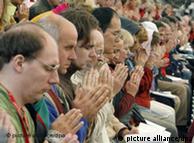 German Buddhists during meditation
German Buddhists during meditation
Gentle or not, significantly more Germans are turning towards Buddhism than are converting to Islam, an issue which has been creating waves throughout Germany lately. Last month, according to the Federal Interior Ministry, there were between 15,000 and 40,000 converts to Islam living in Germany.
So what is the reason for this growing interest in Buddhism, which is not even recognized as a religious body under German public law? David Schneider, one of the senior teachers of the Shambala Buddhist tradition, says one factor is that Buddhism is a particularly tolerant religion which is open to anyone.
"There have never been any Buddhist wars," Schneider said. " I think one of the things that people fear these days are extremist groups in all religions. Being the middle way, Buddhism is against extremism, you cannot be a Buddhist extremist."
Ambassador for Buddhism
The growing profile of the Buddhist way all over the world can at least in part be attributed to the Dalai Lama, the spiritual head of the religion.
"The media has taken a big interest in Buddhism partly because of his Holiness," Schneider said, adding that although he is often seen with world leaders and celebrities, he is a serious monk and practitioner who has not lost his compassion.
"People like a star and he is a star and a wonderful ambassador," he said.
Inken Prohl, a theologist at Heidelberg University, agrees that the German fascination for Asia and Buddhism has much to do with the work and profile of the Dalai Lama, but believes that people are also looking for care and compassion and answers to questions their Christian backgrounds have been unable to provide.
"People are seeking ways to get on with their lives, looking for ways to cope," Prohl said, adding that the main churches neither address the body nor the senses in the way that Buddhism does.
"Appealing to the senses is very important," she said, "and Buddhism does this through meditation, physical exercise and simple aesthetics."
Seeking happiness
There is most certainly an en vogue element to Buddhism in Germany at the moment, but as Latenza from the DBU says that does not make it any less valid. "Some people may be interested on a superficial level, but the fact is that Buddhism does provide answers to today's problems," he said. "People want to learn how to live a happier life."
Buddhism calls for self-reflection, which fledgling practitioner Volker Wieprecht considers "an endlessly valuable gift." After almost two decades of rushing around trying out anything he thought might fill his life with happiness and meaning, he suddenly realized that he could find what he was looking for in what he describes as a "totally reliable philosophical system."
For Wieprecht, Buddhism means "much less drama and much more joy." But he also acknowledges that living the Buddhist way is a life-long project.
Sustainable trend?
That is not the same for everyone, indeed Buddhism lends itself perfectly to the religious dabbler. Anyone is welcome and the extent to which one practices is determined solely by the individual.
But if Buddhism is something which one can dip in and out of, it is unclear how deep its roots in Germany will end up being, or if it will continue to enjoy growth. David Schneider believes that the trend might slow down once people realize the work involved in following the Buddhist path.
"Trend won't get you through. Even if the beautiful and famous people are walking the same path, everyone ultimately has to go it alone," he said. "But given the stresses of modern life, it has a lot to offer."
Buddhism in Germany looks back to a history of over 150 years. Arthur Schopenhauer was one of the earliest Germans who were influenced by Buddhism. Schopenhauer got his knowledge of Buddhism from authors like Isaac Jacob Schmidt (1779-1847). German Buddhists or Orientalists like Karl Eugen Neumann, Paul Dahlke, Georg Grimm, Friedrich Zimmermann (Subhadra Bhikschu) and the first German Buddhist monk Nyanatiloka were also influenced by Schopenhauer and his understanding of Buddhism. But also German Indologists like Hermann Oldenberg and his work ”Buddha, sein Leben, seine Lehre, seine Gemeinde“ had an important influence on German Buddhism.
In 1888 Subhadra Bickshu (Friedrich Zimmermann) published the first edition of the „Buddhistischer Katechismus“, a work based on the "Buddhist Catechism" of Henry Steel Olcott.
In 1903 the first German Buddhist organisation was founded by the Indologist Karl Seidenstücker in Leipzig. In 1904 Florus Anton Gueth became the Theravada monk Nyanatiloka. Some important Pali texts were translated into German in the early part of the 20th century by scholars like Karl Eugen Neumann (1865-1915), Nyantiloka and others.
In 1922 Hermann Hesse published his famous work "Siddhartha", which has been translated into many languages.
In 1924 Dr. Paul Dahlke established the first German Buddhist monastery, the "Buddhistische Haus" in Berlin.
The German Dharmaduta Society, initially known as the Lanka Dhammaduta Society and dedicated to spreading the message of the Buddha in Germany and other Western countries, was founded in 1952.
In 1957 The German Dharmaduta Society purchased the premises of "Das Buddhistische Haus" from the heirs of Dr. Dahlke. It is now a Centre for the spread of Theravada Buddhism in Europe. As the second oldest Buddhist institution in Europe, German authorities have designated it a National Heritage site.
According to the Deutsche Buddhistische Union (German Buddhist Union), an umbrella organisation of the Buddhist groups in Germany, there are about 245,000 active Buddhists in Germany (as of 2005[1]), 50% of them are Asian immigrants. They are organized in about 600 groups. In 1977 there were just 15 Buddhist groups.[
Since 1903 we can observe activities of Buddhists in Germany. It was in 1955 when some 43 German Buddhists met in Frankfurt to found the »German Buddhist Society« which was renamed in 1958 into the present »German Buddhist Union« (DBU). In 1975 the DBU became a founding member of the »Buddhist Union of Europe« (EBU) and since 1961 is a Regional Centre of the »World Fellowship of Buddhists« (WFB).
The German Buddhist Union was and is a platform where Buddhists from all traditions and schools meet and develop understanding and appreciation for the variety and diversity of Buddhist theory and practice.
It is difficult to estimate the actual number of Buddhists in Germany, as many of them practice in private or are only loosely connected to one of the more than hundred Buddhist groups in our country. There are some 120.000 Buddhists of Asian origin living in Germany, most of them Vietnamese refugees, some from Thailand, Taiwan, Cambodia, Korea, Japan and other Asian countries. We estimate about 150.000 Buddhists of German origin. They generally practice in different groups. There are occasions like Vesakh where members of ethnic and German groups meet and co-operate. Some few groups have both Asian and German members. However the contacts are growing more intensive in the last years.
Members
Currently, there are 60 member-groups of the DBU, some of them having many branches all over Germany. For a list of all member-groups (German language), please have a closer look at the page DBU-Mitgliedsgemeinschaften.
Contacts with other Buddhist groups in the country are existing on a friendly level and each year new groups decide to join the DBU. In addition to group members it is also possible for individuals, who want to support Buddhism in Germany, to become members. Currently they are around 2300 individual members.
Activities
Information and Publishing:
Since 1986 the DBU has a national office where information, brochures, programs and the quarterly »Buddhismus Aktuell« can be obtained and which helps to organise and co-ordinate local and national events together with the different Buddhist centres and groups.
The office manages a database of over 600 buddhist groups, all over Germany, which can help interested persons to find a group in their region. Please look at Gruppensuche. On our Website it is also possible to look up buddhist events like talks, workshops and meditation retreats all over Germany. Please look at Veranstaltungssuche.
The quarterly »Buddhismus Aktuell« (formerly »Lotusblätter«) offers a wide range of articles on all Buddhist traditions, reports, book reviews and information on events. It has some 3500 subscribers and sells altogether around 4500 copies of each issue. It is also available in newsstands at the railway stations of major german cities.
Events:
Since 1955 the DBU meets for the annual plenary session in spring and since 1985 it holds aBuddhist Convention in fall, open to the general public. DBU council members, delegates of the member societies, Buddhist teachers and friends from all traditions meet for speeches, guided meditations and inspiring discussions on teaching and practice of Buddhism in a Western country. Please find further information (in German) at: www.buddhismus-kongress.de
There is a growing readiness for local groups to join together to hold regional Dharma days with Dharma talks, guided meditations, films on Buddhism and discussion groups. These events have proved to be very inspiring for the participating Buddhist groups and for the interested – more and more non-Buddhist – public who find great inspiration in this harmonious co-operation of Buddhists of different traditions. The most important regional event is Vesakh which is celebrated around May/June in commemoration of the birth, enlightenement and death of Buddha.
Buddhist studies:
Since March 2004 a two-year study program on all buddhist traditions has started. It is open to all buddhists who want to gain deeper knowledge about the different buddhist traditions. An extended part of the program is also used to train buddhists who are also school teachers to become teachers for buddhist religion in german public schools. In the future it is planned to offer parts of the program to the general public.
Board of the DBU
Here follows the list of the board of directors.
President:
Mark von Rössing, Gießen
Vice-President:
Katrin Baar, Munich
Treasurer:
Traudel Reiss, Sonsbeck
Further Council Members:
- Vajramala (Sabine Thielow), Überlingen
- Michael Gerhard, Mainz
- Manfred Folkers, Oldenburg
- Sören Hechler, Gießen
- SoGen, Ralf Boeck, Monzingen
- Michael Schmidt, Luhden
- Reinhard Türk, Mechernich
- Katharina Weber, Steyerberg
... representing all important buddhist traditions in Germany.
Representative for the WFB: Dorin Genpo Zenji
For further information (also in English) please contact the office of the DBU:
Address:
Deutsche Buddhistische Union e.V.
Amalienstr. 71
80799 Muenchen - Germany
Tel: +49-89-280104
Fax: +49-89-281053
E-mail: dbu@dharma.de
